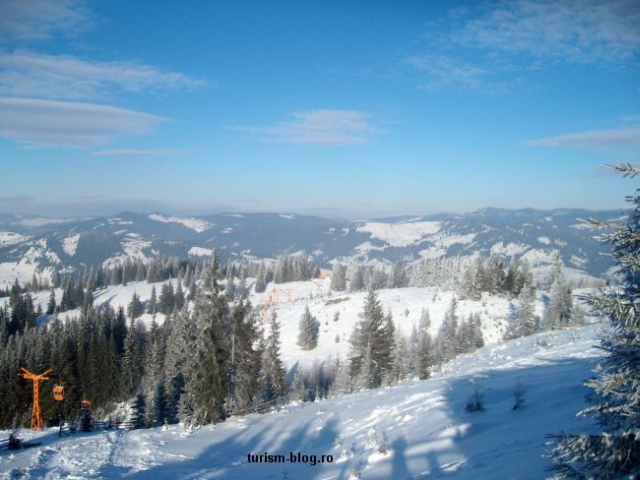Bukovina
Bukovina is a place of great sights, cultural venues, traditions, as well as winter sports.

Daniel Onea, 20.02.2014, 13:02
Our first stop is Cacica Salt Mines. It is located in the centre-west of the county of Suceava, and has been open to visitors since the 19th century. Tour guide Ioana Croitoru tells us more about the history of the mine:
“The entire mine has been worked by hand, with hammer and chisel, by expert miners from Poland and the Ukraine, and everything is made of salt. Cacica means ‘duck’ in Polish. It used to be a marsh populated by wild ducks, hence the name of the mine, given by the Polish. Experts say that the place has salt reserves for 500 more years, given that the mining started in 1791. Inside the mine you can see a small Orthodox chapel with a few salt sculptures. At 38 meters depth there’s also an artificial lake, with salt crystals forming on the edge. You can see there the little boat the miners used to take their children in to see the sights. At 41 meters of depth you can find the ballroom, bearing the name of the general director of the mine. At 70 meters depth we also have a cheese storage facility, because the temperature down here is a constant 10 degrees Celsius. We also have a sports facility there for people who come for treatment, with asthma or other respiratory ailments, as well as a play area for children.”
You can schedule a visit to the mine any day of the week, even on Sundays, between 9 am and 5 pm. Admittance is 10 lei for adults, which is the equivalent of around 2.5 euros, with a 50% discount for children under 14.
The north of Romania is also famous for its monasteries. Bukovina is actually known as Monastery Country. We now invite you on a visit to a monastery which withstood the test of time for the last 500 years. Even though it is not widely known, like Voronet, Putna, Moldovita and Sucevita, Probota convent should not miss from your itinerary. One of the nuns residing here showed us around:
“Probota is the first monastery to be painted on the outside. It was erected in 1530 and its walls painted between 1530 and 1532 by a group of monks. Architecturally, it follows the pattern of big mediaeval churches with burial sites, and blends three elements: Gothic, which prevails, Renaissance, and Moldavian. In the 19th century, the monastery underwent a series of modifications while under Greek administration. The exterior walls were painted; the entrance windows and those of the porch were walled over and the interior walls were covered with new paintings. When its property was seized in 1864, Probota no longer served as a monastery, but as a village church. After the 1989 anti-communist revolution, it became a monastery for nuns, and starting in 1993 it became a UNESCO heritage site. After UNESCO financed its restoration, mostly with Japanese and Romanian funds, the interior painting was washed off revealing the older paintings dating back to 1532, with their exceptional iconography. In 2001, experts declared it the best-preserved monastery in terms of its theological imagery, which best reflect the artistic and liturgical style of the Byzantine Church. In 2001, Probota also received the UNESCO award for its interior painting. While the monastery’s old exterior painting is now largely lost, its interior painting is truly unique.”
Bukovina is also a great place for adventure tourism. Claudiu Bradatan, from the Suceava Tourist Information Centre, tells us what the region has to offer in this respect:
“We like to call this active tourism because it doesn’t necessarily involve extreme sports. In this sense, Vatra Dornei is the ideal destination. A whole range of tourist packages are aimed precisely at this type of tourism. One such example is equestrian tourism. The Calimani National Park, the largest in Suceava county is the best place for horseback riding, as well as trekking, climbing and rafting on the river Bistrita. I also recommend visiting Ciocanesti, a village full of life with a special traditional architecture. The village hosts two big festivals, the Festival of Painted Eggs held in spring, and the Festival of Trout, in the summer.”
Bukovina can be enjoyed by any kind of tourist, including the people coming for relaxation and treatment. They are all invited to Vatra Dornei, according to the head of the local mountain rescue team, Petru Ariciuc:
“As a spa, Vatra Dornei developed in the 1880s-1890s, when the first buildings that make up the core of the resort were erected: the post office, the baths and the city hall. Studies run under the Austro-Hungarian Empire around 1850 showed that it was a good place to build a spa. Today there are three treatment facilities here, which can accommodate around 2,500 people. Vatra Dornei is surrounded by four mountain ranges perfect for trekking, with easy trails of 3-6 hours. You can also spend an entire week up in the mountains, in the Dorna Basin, close to Vatra Dornei. The facilities here provide treatment for ailments of the peripheral nervous system, the system of locomotion and cardiovascular diseases. It’s also worth mentioning that the spa park is very rich in ozone, according to the latest measurements. There are also three walking trails available for people who come here for treatment.”






























